- Accueil
- > Shakespeare en devenir
- > N°18 — 2024
- > L’Œil du spectateur. Play Reviews
- > Henry IV, Our Saviour?
Henry IV, Our Saviour?
Par Sabina Laskowska-Hinz
Publication en ligne le 14 décembre 2024
Article au format PDF
Henry IV, Our Saviour? (version PDF) (application/pdf – 785k)
Texte intégral
Polish Theatre, Warsaw,
William Shakespeare: King Henry IV [Historia Henryka IV]
Director: Ivan Alexandre
Design: Antoine Fontaine
Costumes: Dorota Kołodyńska
Sound: Leszek Lorent
Light: Robert Mleczko
Dramaturgy: Piotr Kamiński
Cast
King Henry IV: Andrzej Seweryn
Prince Henry & Hal: Paweł Krucz
Lancaster/Peto: Dorota Bzdyla
John Falstaff: Szymon Kuśmider
Henry Percy & Hotspur: Modest Ruciński
Lady Percy: Hanna Skarga
Premiere: 10 October 2024
Running time: 3:30 hours
1Ivan Alexandre’s adaptation of William Shakespeare’s King Henry IV—primarily based on Part One of the two Henry IV plays—premiered at Polish Theatre in Warsaw on 10 October 2024. Piotr Kamiński, a known translator of Shakespeare, is responsible for the script. He provides the actors with a semi-modern version of the text that is easy for the audience to follow. Yet the production seems somewhat uneven, divided into two parts: the first addresses problematic plot issues of Shakespeare’s King Henry IV, Part One, while the second part—much shorter—is a compact summary of the battle. The title of the production was slightly altered and elongated to reflect the director’s anecdotal reading of the play The Story of Henry IV with an Account of the Shrewsbury Battle Between Prince Henry and Lord Henry Percy and the Ramblings of Sir Falstaff [“Historia Henryka IV z opisem bitwy pod Shrewsbury między księciem Henrykiem a lordem Henrykiem Percym wraz z szelmostwami sir Falstaffa”].
2William Shakespeare’s 1 Henry IV is a story where serious aspects and comic scenes find a soothing balance. Shakespeare’s audience learns about an unstable military situation, the shedding of fraternal blood, and the precarious situation of a ruler. Henry IV had deprived his predecessor of the crown with the support of allies who have now turned into sour rebels. This plot is contrasted with the comic figure of Sir John Falstaff and his merry companions, who provide the viewer with comic relief. This includes clumsy attempts at robbery, inappropriate wooing, and verbal skirmishes among friends. The playwright offers the audience alternating stimuli for thought and laughter.
3Ivan Alexandre remains faithful to the unfolding of the story. The stage design, costumes, and props instil a religious atmosphere. A structure framing the stage enhances the indication of various iconographic references. Giant black machines take over the stage. All elements are adjusted on a round platform. A mechanism rotates the construction of two massive symmetrical four-sided towers with balconies at the top, where the musical instruments are placed, and the passages that join them. The symmetry, its right angles, and intersecting paths provide solid frames for individual scenes. Thus, the space between the towers constitutes enormous painting frameworks for animated images of duels [Figure 1], i.e. military scenes, figure portraits or a still life with royal insignias.

Figure 1. Douglas (Tomasz Błasiak) and Sir Walter Blunt (Antoni Ostrouch).
Crédits. Krzysztof Bieliński. Property of Polish Theatre, Warsaw.
4Each rotation of the construction generates a different kind of space which allows the audience to visit a public room at the castle, the bedroom in Mistress Quickly’s tavern, training chambers in Northumberland, or the house of the archdeacon of Bangor. In the end, the stage turns into a battlefield. The machinery plays a symbolic role: fortune changes. Music, stage lights and dark costumes enhance an atmosphere of a massive scale, as sometimes experienced in the vast interiors of modern churches.
5The production poster is the performance’s most significant asset to promote its painterly character and includes numerous references to Western European art [Figure 2]. The image provides a short glimpse of what the audience might expect on stage. However, this advertisement of Alexandre’s Henry IV could also be slightly misleading, though it reveals the formal nature of the adaptation. Four men in the centre pose against a dark background. They are paired according to age and prospect of success. In the foreground are two sitting figures: Szymon Kuśmider’s Falstaff and Andrzej Seweryn’s King Henry IV (from left). Two younger men standing right behind them are Modest Ruciński’s Lord Henry Percy (Hotspur) and Paweł Krucz’s Prince Henry (Hal) [Figure 3].

Figure 2. Frans Badens, Civic Guardsmen from a company of the Crossbow Civic Guard [a detail], 1613, Amsterdam Museum (URL).
Crédits. Karolina Jóźwiak. Property of Polish Theatre, Warsaw.

Figure 3. Poster: Historia Henryka IV z opisem bitwy pod Shrewsbury między księciem Henrykiem a lordem Henrykiem Percym wraz z szelmostwami sir Falstaffa [The Story of Henry IV with an Account of the Shrewsbury Battle Between Prince Henry and Lord Henry Percy and the Ramblings of Sir Falstaff].
Crédits. Karolina Jóźwiak. Property of Polish Theatre, Warsaw.
6The poster is arranged to remind viewers of old Dutch paintings by Frans Hals or Rembrandt. The facial expressions, gestures, and props are taken almost directly from these painters’ works. Eventually, the poster references the 17th-century Western European art heritage with a similar application of chiaroscuro, colours, composition, and military character. Chiaroscuro and the contrast between light and darkness are prominent in this production.
7The Polish stage adaptation opens with the king expressing his hopes for peace: Henry IV (Andrzej Seweryn) stands in the centre of a cross formed by two elevated and crossed footbridges—a beam of bright light from above illuminates his rigidly upright form wearing a crown of thorns, holding a long spear. The dark atmosphere and his monotonous speeches establish the king’s sublimity, and he becomes an incarnation of a Christ—a defender of Death and Evil [Figure 4]. The opening parallels the closing scene when the battle ends, corpses remain on a sandy stage, and the survivors are on their knees. The king, still wearing the crown of thorns, occupies the central space. A faint light from above illuminates his figure and Henry IV—on his knees—later prays to God. Nooses hang high above the actors’ heads, except the king [Figure 5]. Thus, Henry IV seems to be portrayed as a Christian saviour in this adaptation.

Figure 4. The opening scene.
Crédits. Krzysztof Bieliński. Property of Polish Theatre, Warsaw.
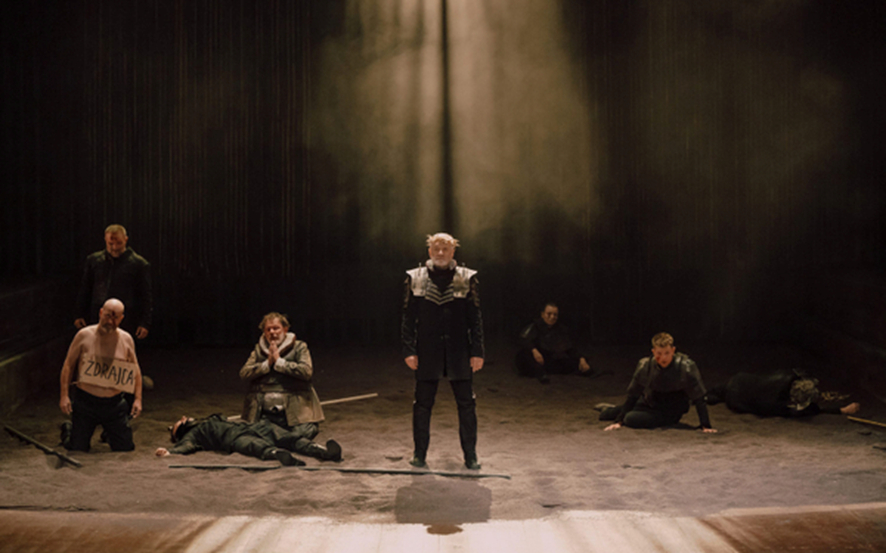
Figure 5. The ending scene.
Crédits. Karolina Jóźwiak. Property of Polish Theatre, Warsaw.
8There are numerous intertextual references in this production, either verbal or iconographical. The characters share lines from other Shakespearean plays: for example, Falstaff calls out, “Hal! A plague upon you both!” (1 Heny IV, II.2.19-20), echoing Mercutio in Romeo and Juliet. The Director Alexandre additionally enriches the adaptation by introducing iconic stage arrangements, e.g. a balcony scene, where, in this case, Hal (Paweł Krucz) and Falstaff (Szymon Kuśmider) remind us of Juliet and Romeo [Figure 6]. He also adds a graveyard scene, suggesting a Hamlet reference, but here the protagonist is replaced by Falstaff holding a scull in the middle of a sandy battlefield [Figure 7].
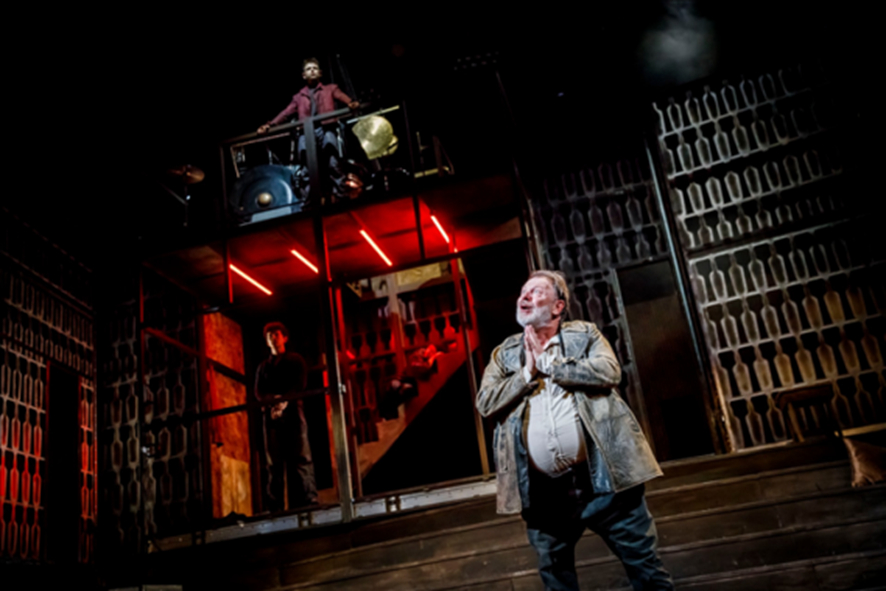
Figure 6. Hal (Paweł Krucz) and Falstaff (Szymon Kuśmider).
Crédits. Krzysztof Bieliński. Property of Polish Theatre, Warsaw.
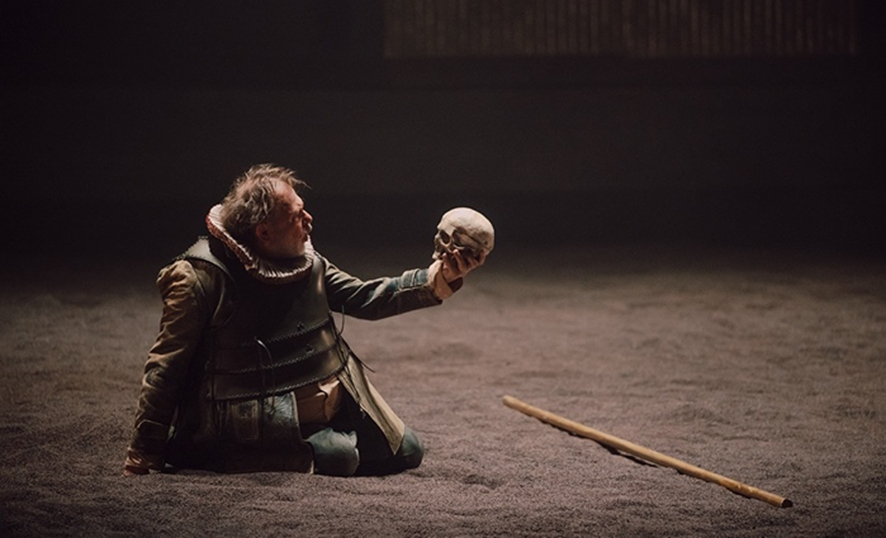
Figure 7. Falstaff (Szymon Kuśmider) on a battlefield.
Crédits. Karolina Jóźwiak. Property of Polish Theatre, Warsaw.
9Alexandre and his stage designer Fontaine reach for further references and allusions when they evoke reminders of Beckett’s Winnie from his Happy Days. The Welsh hero Owen Glendower (Sławomir Grzymkowski) is dug into the sandy surface of the stage. He appears as a supernatural creature with a crown hovering in the air just behind him [Figures 8, 9].
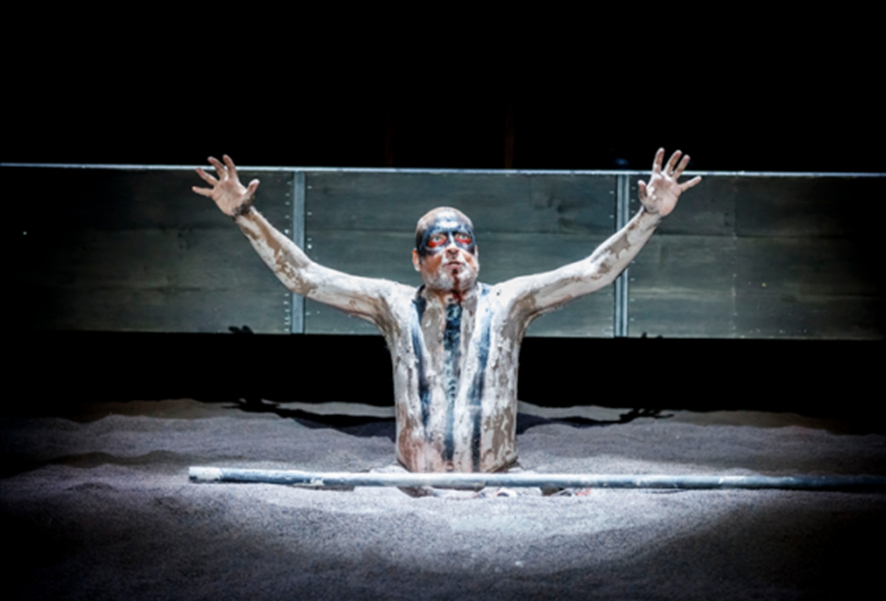
Figure 8. Owen Glendower (Sławomir Grzymkowski).
Crédits. Krzysztof Bieliński. Property of Polish Theatre, Warsaw.
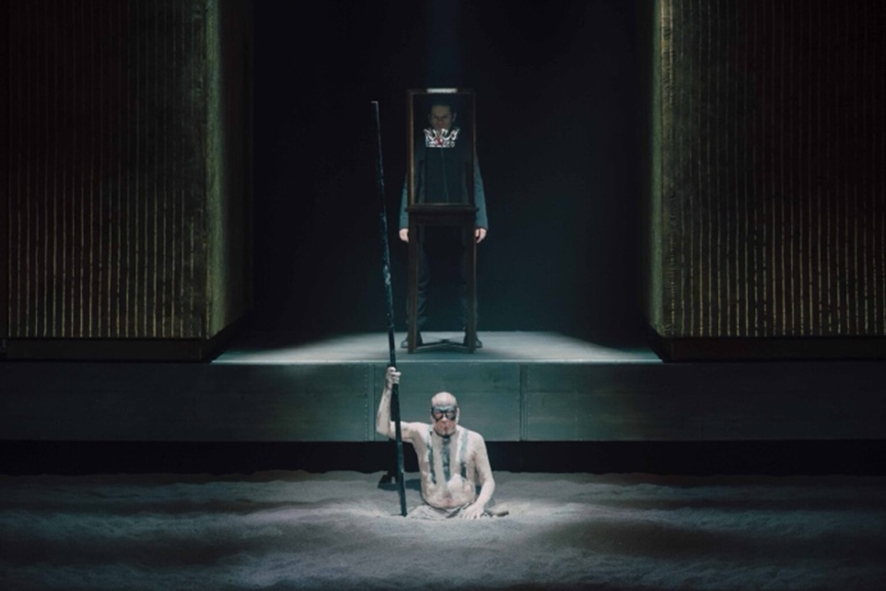
Figure 9. Owen Glendower (Sławomir Grzymkowski) and the crown.
Crédits. Karolina Jóźwiak. Property of Polish Theatre, Warsaw.
10Here, just in front of Glendower, the rebels Northumberland and his son Hotspur (Modest Ruciński) draw and divide a map of England, Scotland and Wales among themselves. It is as if they were building sandcastles in the air. This comparison already indicates the failure of this company. After the battle, Hal [then Falstaff, Figure 10] will stand over the dead body of Hotspur as an image of Saint George over the slaughtered dragon [Figure 11].
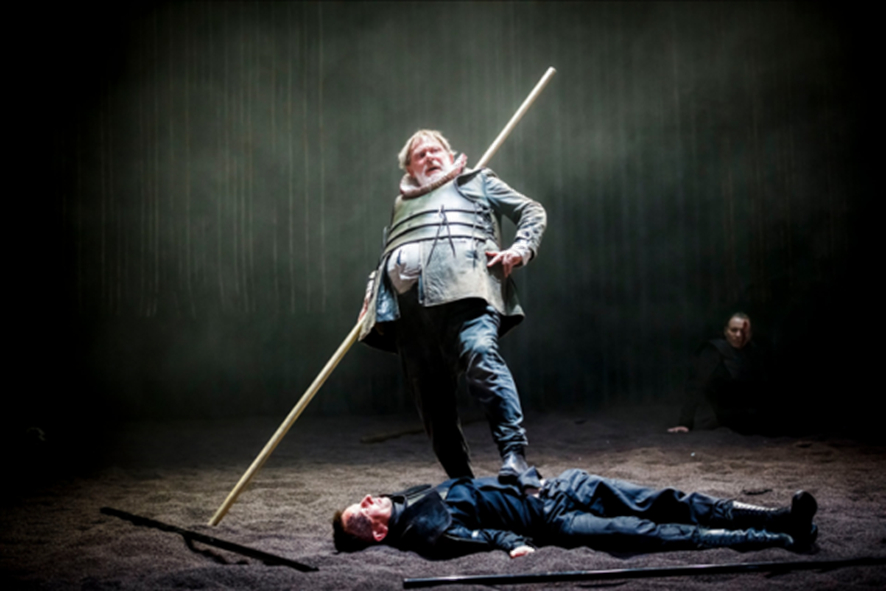
Figure 10. Falstaff (Szymon Kuśmider) over the body of Hotspur (Modest Ruciński).
Crédits. Krzysztof Bieliński. Property of Polish Theatre, Warsaw.

Figure 11. Saint George fighting with a dragon, a sculpture crowning the Court of the Brotherhood of Saint George, 1566, Gdansk (URL).
11There is little space for femininity in this overwhelming male theatrical world of Shakespeare’s drama. Only two female characters appear on stage. They play the conventional roles of sexually aroused, demanding, and manipulative people. In Warsaw, costumes underline their lechery. The audience witnesses Mistress Quickly (Katarzyna Strączek) in flagrante delicto with a naked Hal. In a highly intimate scene, she only wears a light celadon, an unbuttoned shirt, for the whole scene [Figure 12]. Lady Percy (Hanna Skarga), in contrast, wears tight black trousers and a corset with exposed shoulders and a prominent neckline [Figure 13]. This provocative outfit highlights the behaviour towards her husband: she constantly demands intimacy, fakes sexual intercourse, kisses, and caresses his naked chest. Femininity in this production is limited to erotism and the only women in this drama are a whore and a lusty wife.
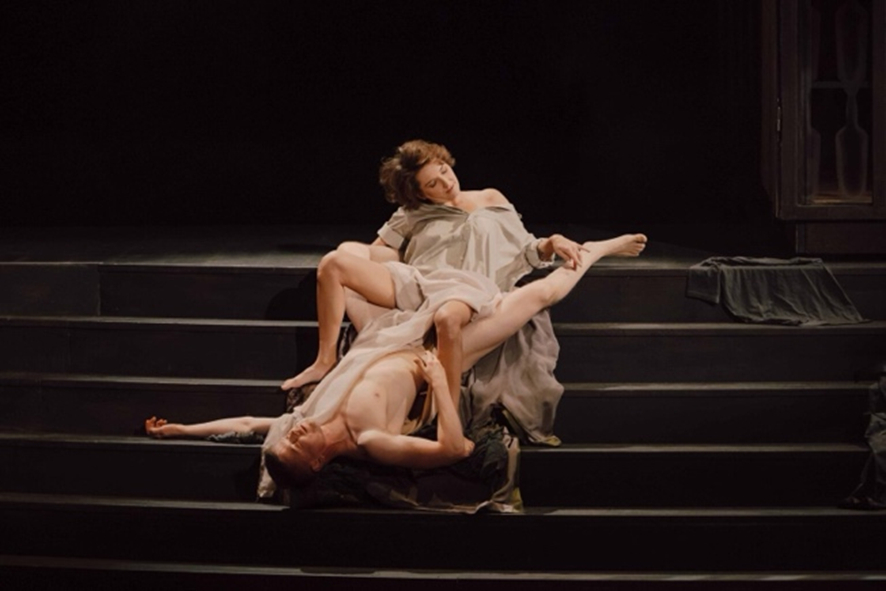
Figure 12. Mistress Quickly (Katarzyna Strączek) and Hal (Paweł Krucz).
Crédits. Karolina Jóźwiak. Property of Polish Theatre, Warsaw.
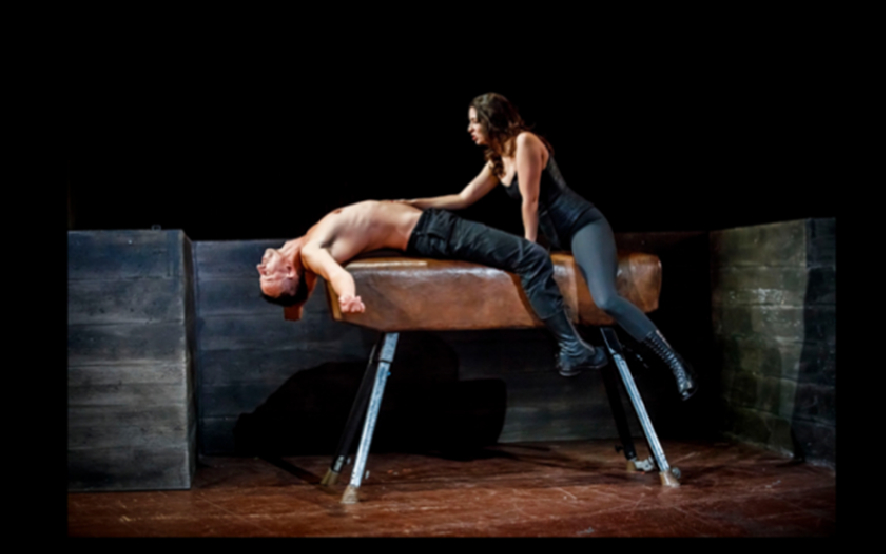
Figure 13. Hotspur (Modest Ruciński) with his wife, Lady Percy (Hanna Skarga).
Crédits. Krzysztof Bieliński. Property of Polish Theatre, Warsaw.
12However, there is one more female actor (Dorota Bzdyla) playing two male figures in Alexandre’s adaptation: as Peto, Bzdyla identifies with the male side of this role—she is a tomboy, troublemaker, and happy companion to Hal. As John of Lancaster, Hal’s younger brother, her appearance is somewhat different: she supplements the character with delicacy and gentleness, characteristic of youth and possibly effeminacy. The emotional scenes between the brothers and how Hal takes care of younger prince after the battle reveal a compassionate human side of the king-to-be. Bzdyla, in this double role, highlights glimpses of gentleness in the male world of treachery, battles, and death.
13Since 1902, fifteen Polish adaptations of King Henry IV have been produced. This production, the second in the 21st century,1 is a treat for Shakespeare theatre enthusiasts.
Bibliographie
SHAKESPEARE, William, King Henry IV, Part 1., ed. David Scott Kastan, London, Bloomsbury, The Arden Shakespeare, 2019.
SHAKESPEARE, William, Dzieła w przekładzie Macieja Słomczyńskiego. Pierwsza Część Dziejów Króla Henryka IV [The First Part of King Henry IV], trans. Maciej Słomczyński, Kraków, Wydawnictwo Literackie, 1987.
Notes
1 The previous 21st-century production of Henry IV Part I premiered on 4 November 2005, directed by Jan Kulczyński and performed by Scena Inicjatyw Artystycznych [Artistic Initiatives Stage], Warsaw. In Poland, there have only been sixteen theatre productions of Henry IV since 1902 (most of them in the 1960s and 1970s). URL.
Pour citer ce document
Quelques mots à propos de : Sabina Laskowska-Hinz
Droits d'auteur

This is an Open Access article distributed under the terms of the Creative Commons Attribution License CC BY-NC 3.0 (https://creativecommons.org/licenses/by-nc/3.0/fr/) / Article distribué selon les termes de la licence Creative Commons CC BY-NC.3.0 (https://creativecommons.org/licenses/by-nc/3.0/fr/)